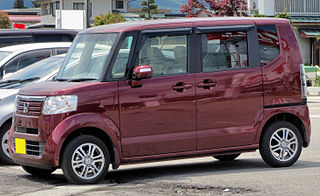
Kei car, is the Japanese vehicle category for the smallest highway-legal passenger cars, with restricted dimensions and engine capacity. Similar Japanese categories exist for microvans, and kei trucks. These vehicles are most often the Japanese equivalent of the EU A-segment.
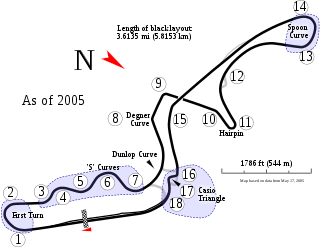
The Japanese Grand Prix is a motor racing event in the calendar of the Formula One World Championship. Historically, Japan has been one of the last races of the season, and as such the Japanese Grand Prix has been the venue for many title-deciding races, with 13 World Drivers' Champions being crowned over the 36 World Championship Japanese Grands Prix that have been hosted. Japan was the only Asian nation to host a Formula One race until Malaysia joined the calendar in 1999.
After an early flirtation with V-twin engines, Mazda's small cars of the 1960s were powered by OHV straight-2 and straight-4 engines. This family lasted from 1961 until the mid-1970s. Today, Mazda's keicars use Suzuki engines. It was produced at the Hiroshima Plant in Hiroshima, Japan.

The Daihatsu Fellow Max is a small Japanese automobile in the Kei car class. Originally introduced as the Daihatsu Fellow, the name was partially retained for the Max Cuore (1977) and then again for the 2000 Daihatsu Max.

The Daihatsu Charmant is a subcompact sedan built by Daihatsu of Japan, based on the Toyota Corolla. It was succeeded by the Daihatsu Applause two years after Charmant production ended. The Charmant was heavily based on the E20 Toyota Corolla; model changes paralleled those of the Corolla. All Charmants were fitted with Toyota inline-four engines, ranging from 1.2 to 1.6 litres. The word charmant is French for "charming."
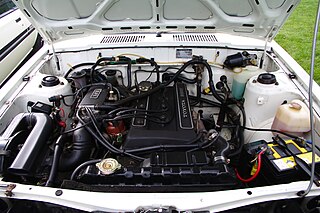
The Toyota T series is a family of inline-4 automobile engines manufactured by Toyota beginning in 1970 and ending in 1985. It started as a pushrod overhead valve (OHV) design and later performance oriented twin cam (DOHC) variants were added to the lineup. Toyota had built its solid reputation on the reliability of these engines.

The Suzuki Fronte is an automobile that was first introduced in March 1962 as a sedan version of the Suzulight Van. The nameplate remained in use for Suzuki's Kei car sedans as well as some commercial-use derivatives until it was replaced by the Alto name in September 1988. The word "fronte" alludes to the fact that the car is front-wheel-drive, although during the years when the Fronte was rear-engined, rear-wheel-drive, Suzuki stated that it referred to the car being at the front of the Kei class.

The Daihatsu Hijet is a cab over microvan and kei truck produced and sold by the Japanese automaker Daihatsu since 1960. Despite the similarities between the Hijet name and Toyota's naming scheme for its trucks and vans, the name "Hijet" has been in use for Daihatsu's kei trucks and microvans since 1960, over two decades before Toyota took control. "Hijet", when transliterated into Japanese, is very similar to "Midget", one of Daihatsu's other mini-trucks. According to Daihatsu, the name "Hijet" was created to imply that the vehicle offers higher performance than the Midget. The Hijet competes in Japan with the Honda Acty, Mitsubishi Minicab, Nissan Clipper, Subaru Sambar and Suzuki Carry.

The Isuzu Bellett is a subcompact car produced by the Japanese manufacturer Isuzu between 1963 and 1973. Designed by Isuzu, the Bellett replaced the Isuzu Hillman Minx, manufactured by Isuzu under license with the Rootes Group.

The Toyota Dyna is a light to medium-duty cab over truck for commercial use. In the Japanese market, the Dyna is sold alongside its twin called the Toyoace. The Toyoace was a renaming of the Toyopet SKB Truck as a result of a 1956 public competition with 200,000 entries. "Dyna" is short for dynamic.

The Mitsubishi Colt Galant GTO was first shown as the Galant GTX-1 showcar at the 1969 Tokyo Motor Show. Sales began in November 1970, when it was the flagship hardtop variant of Mitsubishi Heavy Industries's then-new Colt Galant sedan. The nameplate was revived in 1990 for the Mitsubishi GTO, although this name was only used in the Japanese domestic market.
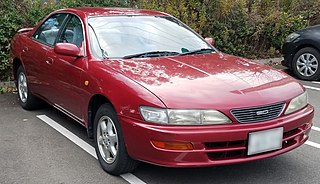
The Toyota Carina ED is a compact car manufactured by Japanese automaker Toyota in 1985 as a companion to the 1984 Carina sedan. It was positioned as the four-door Celica, with a similar focus on luxury found on larger Toyota hardtop sedans, like the Toyota Crown and the Toyota Cresta. It was the counterpart of the Corona EXiV. Its design sought to emulate the hardtop four-door coupé styling of large American and European sedans, resulting in a small, low cabin with longer front and rear ends. The ED's B-pillar stood up in the middle with no purpose other than to hinge the rear door on; it was not attached to the roof side of the cabin. The ED achieved huge sales in Japan, and other Japanese manufacturers introduced the Mazda Persona, Nissan Presea, and Mitsubishi Emeraude around the same time. "ED" is the initials of "Exciting" and "Dressy". When the Carina ED was discontinued, the Toyota Brevis appeared for the market segment served by the Carina ED.

LC10 was the original name given to a series of very small three-cylinder, two-stroke engines built by Suzuki Motor Corporation in the 1960s and 1970s. They were used in a number of kei class automobiles and light trucks. The LC10 and its derivatives did not completely replace the FE and L50 two-cylinders, which continued to be used mainly for light commercials. The LC10 engine was developed together with the Suzuki B100 engine, a 8–11 PS (5.9–8.1 kW) 118.9 cc (7.26 cu in) single-cylinder motorcycle engine which shared the same bore and stroke. For longevity and convenience, the LC10 received Suzuki's new "Posi-Force" auto-lubrication system, eliminating the need for pre-mixed fuel.

The automotive industry in Japan is one of the most prominent and largest industries in the world. Japan has been in the top three of the countries with the most cars manufactured since the 1960s, surpassing Germany. The automotive industry in Japan rapidly increased from the 1970s to the 1990s and in the 1980s and 1990s, overtook the U.S. as the production leader with up to 13 million cars per year manufactured and significant exports. After massive ramp-up by China in the 2000s and fluctuating U.S. output, Japan is currently the third largest automotive producer in the world with an annual production of 9.9 million automobiles in 2012. Japanese investments helped grow the auto industry in many countries throughout the last few decades.
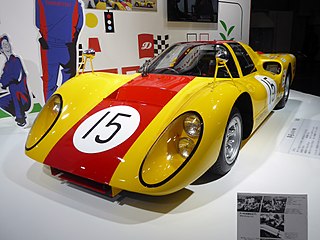
The Daihatsu P-5 was a sports racing car built by Daihatsu in 1967. It was an evolution of the P-3, and featured a 1.3-litre twin-cam straight-four engine capable of producing around about 130-140 PS.

The Suzuki FB engine is a series of two- and three-cylinder two-stroke engines that was produced by the Suzuki Motor Corporation from October 1961 until November 1987. They were used in a number of Kei-class automobiles and light trucks. From the original air-cooled 359 cc (21.9 cu in) straight-twin version the FB series developed through a number of different models having different names, ending with the water-cooled, three-cylinder LJ50. The names used for various versions of this engine often refer to the chassis code of the cars in which they were introduced, until Suzuki changed their engine naming system sometime in the first half of the 1970s.
The Daihatsu Hi-Line/F series is a series of compact trucks, manufactured and sold from 1960 to 1972. This truck series was competed with Toyota Stout, Nissan Junior, Hino Briska or Mazda B series.
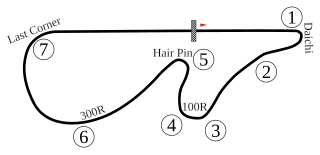
The 1975 Japanese Grand Prix was held at Fuji Speedway from 3 to 4 May 1975.

Yoshikazu Sunako was a Japanese motorcycle racer and racing driver.
















